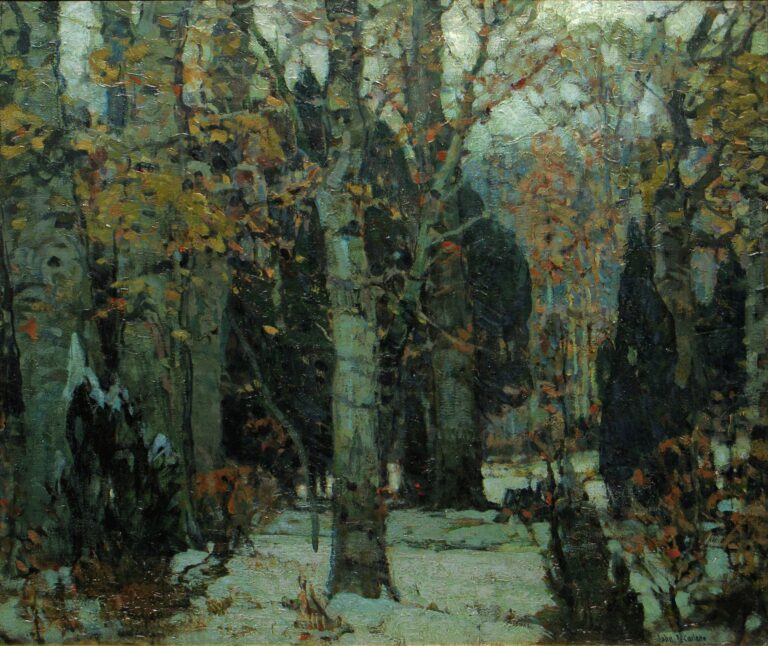The Ghost Stories of Muriel Spark

It’s October, and so I’ve been reading ghost stories. Ghosts are border-crossers, the natural denizens of a month that lays itself down as a bridge between seasons. They don’t belong in every time and place, just where boundaries have degraded. It’s not a big surprise then that even realist writers find themselves occasionally penning ghost stories, when they think of thin places and times. What is more interesting is whether and how these writers choose to work within or outside the long, existing tradition of the ghost story.
Muriel Spark is best known for her beloved short novel The Prime of Miss Jean Brodie (1961). Spark was also a writer of short stories, some of which were ghostly. Enough, in fact, to fill an entire collection. The Ghost Stories of Muriel Spark (2003) contains a few entries that follow traditional paths in one way or another; most, however, are very strange tales. More often than not, Spark tests the old tropes by giving them a firm twist.
To understand the choices she makes, we first need to understand what a ghost does to a story. Plenty of literature points towards our mortality, but ghost stories have a special, heightened relationship with the distance between life and death. The opening of Joy Williams’s The Quick and the Dead, for example, asks, “The dead have certain obligations. Is one of them to remember us?” A ghost story’s answer to that delightfully strange question is almost always, “Yes.” A ghost story asks the dead to not only remember, but also, frequently, to guide us from their state of special knowledge that is death. Because of this, a ghost is often a moralizing force, reminding us of what we’ve done and failed to do. A Christmas Carol is the classic example of this tradition.
In Spark’s “The Executor,” a woman named Susan becomes assistant and executor to her uncle’s literary estate. She sells all of his correspondence and manuscripts to a foundation but holds back one valuable piece—an unfinished novel. The book is a “strong and cruel” one about a witch who is slowly trapped and then forced to await her execution. It is missing only a single, climactic chapter, which Susan decides to write herself in order to raise the price of the manuscript. At this point, Susan begins to receive ghostly notes from her uncle, notes that mock her for various indiscretions, and for being unable to finish the chapter. A traditional moralizing ghost is rarely a terrifying one, but even so, such encounters aren’t typically played for laughs. Still, Spark does exactly that: in “The Executor,” the ghost’s vigilance is an annoyance rather than a true horror. At one point, the entrepreneurial but prayerful niece asks God to “make me strong, and guide and lead me as to how Mrs. Thatcher would conduct herself in circumstances of this nature.” In the end, the foundation calls and asks about the missing manuscript, which was mentioned in one of the uncle’s letters. The dramatic energy fizzles, and though the niece’s plan is a failure, so too does the uncle’s ghost fail to execute the kind of fatal cruelty promised by his novel. Spark denies her ghost the glory of his moral coup.
A ghost story can also be hauntological—focused on an obsession with a particular disappeared possibility. This kind of ghost is a semi-manifested memory or vision of the future, an externalized history, visible but intangible. This tradition of ghost story can get a little more interesting than the moralizing kind (though a story can be both)—it gives us Fritz Leiber’s “Smoke Ghost,” not to mention the opening lines of The Communist Manifesto.
“The Leaf-Sweeper” is one of Spark’s contributions to this tradition. Johnnie Geddes is a man who hates Christmas. He publicly argues against the holiday in a Scrooge-esque pamphlet called “How to Grow Rich at Christmas”: “It sounded very likely, but it turned out that you grow rich at Christmas by doing away with Christmas.” His neighbors get so fed up with this pamphlet and his speeches that they throw Johnnie in the local insane asylum. He is told to sweep up the leaves on the asylum grounds. The narrator sees Johnnie for many years, sweeping up those leaves. One day, she goes to visit Johnnie’s aunt and finds her haunted by a different version of the man—the “ghost” of the still-living Johnnie. This is a comparatively solid ghost. He talks, walks, and can touch things, but he’s not alive. When he cuts himself while slicing cake, he doesn’t bleed. This version of Johnnie is obsessed with Christmas, which disturbs his aunt and the narrator. Stories that are haunted by history or the future, or another way we could have been, usually rely on a sense of separation between the living, breathing, haunted humans and their vision. The intangibility of the apparition is typically the source of our reaction, whether that be nostalgia, despair, hope. In “The Leaf-Sweeper,” on the other hand, the narrator is able to touch and speak with his doppelganger and the story ends with him being introduced to the original Johnnie. The two versions of Johnnie meet and sweep together, finally combining into one whole. Interestingly, he’s not a “cured” whole—Johnnie continues to live as an outsider, sweeping leaves. He remains a man apart from society, though quieter and more contemplative than he had been before.
In a few cases, a ghost story doesn’t seem to fit into one of the above categories. These are the Weird ghost stories, the does-this-even-count-as-a-ghost stories. Such narratives account for some of the oldest and most venerated in the English language. M.R. James wrote almost exclusively in this vein—his “ghosts” were typically strange monsters or demons (never a well-documented supernatural being like a vampire or werewolf). Even so, James is unquestionably one of the foremost writers of the English ghost story, and the tradition in which he worked looms large.
Spark actually plays the weird ghost story relatively “straight,” though really that’s just to say that there is no such thing as totally straight, where the weird tale is concerned. “The House of the Famous Poet” is my favorite of Spark’s. In it, the year is 1944 and a young woman is drawn into an unexpected but prolonged visit at a house whose famous owner is laying low in the countryside. As the woman is leaving the house, a possibly-dead, possibly-archetypal soldier sells the young woman an “abstract funeral.” At first, she is drawn to her purchase, then she attempts to return it, and finally tosses it out a train window. “Out of the window I chucked all my eight and sixpence worth of abstract funeral,” she says. “I watched it fluttering over the fields and around the tops of camouflaged factories with the sun glittering richly upon it, until it was out of my sight. In the summer of 1944 a great many people were harshly and suddenly killed.” The final release of her abstract funeral, leading directly to the plain statement of widespread death captures our narrator’s final turn from avoidance to grim apprehension. Before this point, her story had been haunted by an unnamed dread. Spark uses the slippery nature of the Weird narrative to capture our deep uncertainty around the fatedness of death, and our fundamental inability to look at its horror concretely. And unlike the other stories, “The House of the Famous Poet” is plenty scary.
Some writers specialize in horror, and some in the mundane. Other writers cross that thin border when they need to. As Spark writes in “The Executor”: “The people and the action were in the foreground, full of color . . . . Then in the distance, at the far end of a vast plain, there he would be, a speck on the horizon, always receding and always there, and always a necessary and mysterious component of the picture.” In her ghost stories, Spark invites us to spend time on that horizon. She lures us momentarily from our world of color and people, before releasing us back to normal life. She knows, however, that even one crossing will change us. Comfortably back in the foreground, our gaze will nevertheless drift back to that distant speck.


